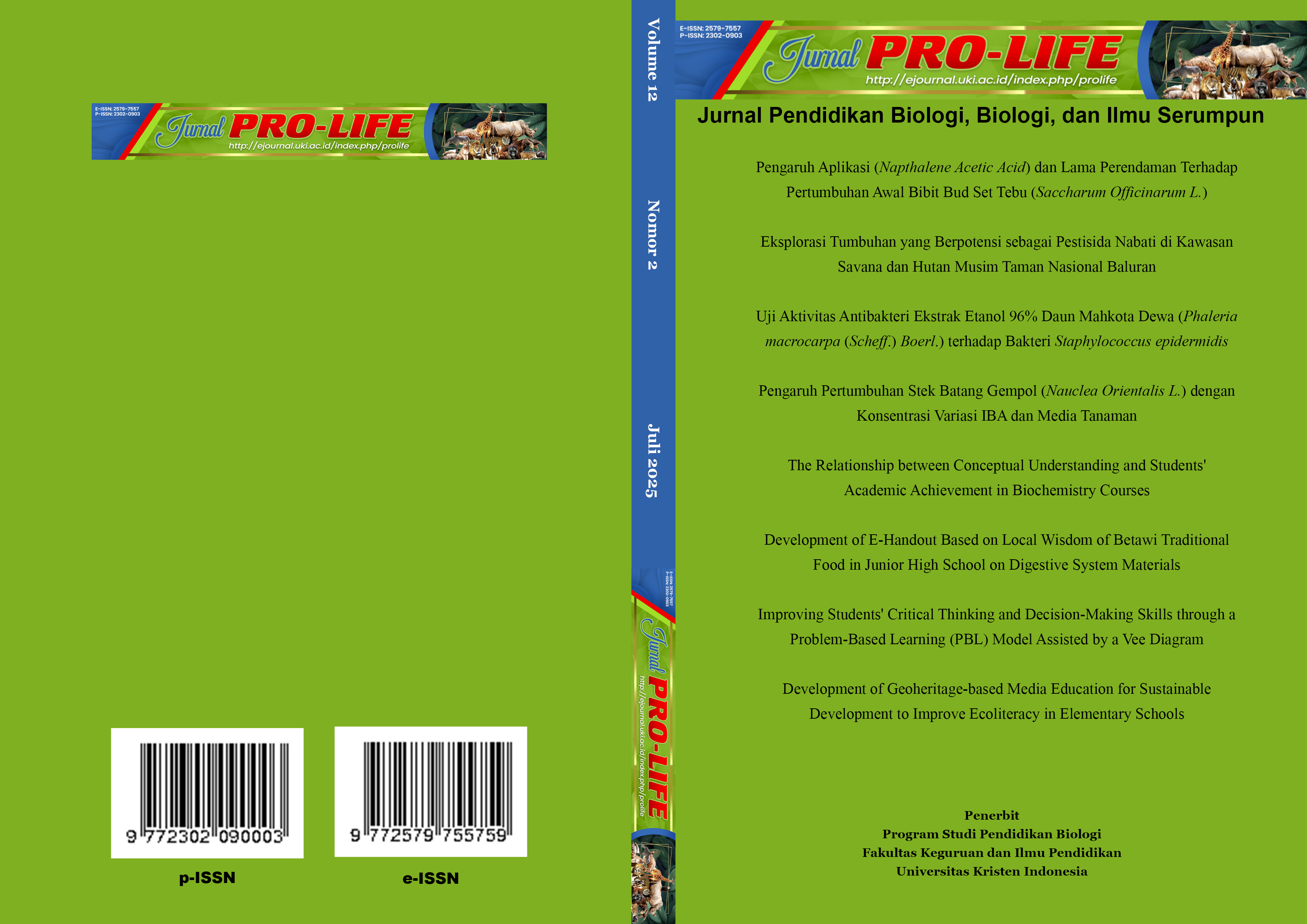Improving Students' Critical Thinking and Decision-Making Skills through a Problem-Based Learning (PBL) Model Assisted by a Vee Diagram
DOI:
https://doi.org/10.33541/pro-life.v12i2.7052Keywords:
critical thinking skills, decision making skills, diagram vee, problem-based learning, biology learningAbstract
This study is driven by the persistently low levels of students' critical thinking and decision-making skills, despite the implementation of various student-centered learning models such as Problem-Based Learning (PBL). Previous studies have focused mainly on PBL alone, with little attention to visual tools like the Vee diagram, which can enhance understanding and reasoning by helping students organize and reflect on information. However, the effectiveness of integrating the Vee diagram within the PBL framework in improving critical thinking and decision-making skills among high school students remains underexplored, indicating a research gap. This quasi-experimental study aims to evaluate the effectiveness of Vee diagram-assisted PBL compared to conventional PBL in enhancing students' critical thinking and decision-making skills. The study was conducted with 11th-grade science students at SMA Negeri 1 Lebakwangi, Kuningan. Data collection instruments included a critical thinking test (essay format), an observation sheet to assess decision-making skills, and a questionnaire to capture student perceptions of the PBL approach. Data were analyzed using the Independent Samples t-test. The results indicate that students taught using the Vee diagram-assisted PBL model demonstrated significantly greater improvement in critical thinking skills than those taught with conventional PBL. Decision-making skills were also higher in the Vee diagram-assisted PBL group. A positive and significant correlation was found between students' critical thinking and decision-making skills.
References
Agustira, D., Al-Muhdhar, M. H. I., Lestari, S. R., & Pratiwi, R. T. (2025). Development of a project-based learning model with multiliteracy pedagogic content to improve critical thinking skills, problem solving skills, decision making skills, and environmental literacy. Edelweiss Applied Science and Technology, 9(3), 2402–2412. https://doi.org/10.55214/25768484.v9i3.5812
Arends, R. (2012). Learning to teach (H. Prajitno & S. Mulyani, Trans.). New York: McGraw Hill Company.
Darwati, I. M., & Purana, I. M. (2021). Problem Based Learning (PBL): A learning model to develop students' critical thinking. Psychology, 12(1), 61–69. https://doi.org/10.46650/wa.12.1.1056.61-69
Ennis, R. H. (1996). Critical thinking dispositions: Their nature and assessability. Informal Logic, 18(2–3), 165–182.
Flavell, J. H. (1979). Metacognition and cognitive monitoring: A new area of cognitive-developmental inquiry. American Psychologist, 34(10), 906–911.
Gowin, D. B. (1981). Educating: A design for practice. Ithaca, NY: Cornell University Press.
Handayani, A., & Koeswanti, H. D. (2021). Meta-analysis of Problem Based Learning (PBL) learning models to improve creative thinking skills. Journal of Basic Medicine, 5(3), 1349–1355. https://doi.org/10.31004/basicedu.v5i3.924
Harasym, P. H., Tsai, T. C., & Munshi, F. M. (2013). Is problem-based learning an ideal format for developing ethical decision skills? Kaohsiung Journal of Medical Sciences, 29(10), 523–529. https://doi.org/10.1016/j.kjms.2013.05.005
Husen, A., Indriwati, S. E., & Lestari, U. (2017). Improving critical thinking skills and science process skills of high school students through the implementation of problem-based learning combined with think pair share. Journal of Education, Postgraduate Biology Education, State University of Malang.
Jumhur, A. A., Avianti, R. A., Nurfitri, P. E., & Mahir, I. (2024). Implementation of problem-based learning to improve critical thinking ability of vocational students in Jakarta. Jurnal Pendidikan, 5(5), 16–24.
Krismawati, A., Arigethi, V. P., & Prayogo, M. S. (2024). Analysis of the application of the Problem Based Learning (PBL) model to student learning outcomes in grade 3 thematic learning at SDN Mangli 02 Jember. Journal of Equatorial Education and Learning, 13(2), 330–335. https://doi.org/10.26418/jppk.v13i2.72992
Meltzer, D. E. (2002). The relationship between mathematics preparation and conceptual learning gain in physics: A possible "hidden variable" in diagnostic pretest scores. American Journal of Physics, 70(12), 1259–1268.
Nakano, T. de C., & Wechsler, S. M. (2018). Creativity and innovation: Skills for the 21st century. Studies of Psychology (Campinas), 35(3), 237–246. https://doi.org/10.1590/1982-02752018000300002
Novak, J. D., & Gowin, D. B. (2006). Learning how to learn. Cambridge, MA: Cambridge University Press.
Oktavianti, N. I., & Purnomo, A. B. (2024). Application of guided inquiry learning model to improve students' critical thinking skills. Biochephy, 4(2), 712–725. https://doi.org/10.52562/biochephy.v4i2.1257
Philosophy, D. K. (2008). Uncovering the secrets of critical and creative thinking. Jakarta: Prestasi Pustaka.
Pratiwi, R. T., Rosaline, C. D., Nuryatin, A., Ningrum, D., Agustira, D., Rahmawati, T., & Fadli, M. F. (2025). Application of the project-based learning model based on lesson study to improve students' critical thinking skills. Edunity, 4(3), 111–122.
Sanova, A. (2013). Implementation of the Problem Based Learning (PBL) method assisted by the Vee diagram in virtual lab-based chemistry learning to improve understanding of learning concepts. Journal of the Indonesian Society of Integrated Chemistry, 5(2), 31–38.
Sapuroh, S. (2010). Analysis of students' learning difficulties in understanding biological concepts in the Monera concept. Unpublished manuscript.
Savery, J. R. (2006). Overview of problem-based learning: Definitions and distinctions. Interdisciplinary Journal of Problem-Based Learning, 1, 9–20. http://dx.doi.org/10.7771/1541-5015.1002
Seifert, K. L., & Hoffnung, R. J. (1994). Child and adolescent development. New York: Houghton Mifflin Company.
Srimadevi, T., & Saraladevi, K. (2016). Decision making and self-confidence on problem solving ability among higher secondary school students studying in mathematics. International Journal of Innovative Research in Science, Engineering and Technology, 5(3), 3509–3514.
Sriwati, I. G. A. P. (2021). Application of the problem-based learning model to improve students' mathematics learning outcomes. Indonesian Journal of Educational Development, 2(2). https://doi.org/10.55215/pedagogia.v14i1.4787
Suryabrata, S. (2004). Educational psychology. Jakarta: Raja Grafindo Persada.
Tanglang, N., & Ibrahim, A. K. (2016). Proposed training module on goal setting and decision-making skills for distant learners. Journal of Education and Training Studies, 4(1), 185–190.
Twins & Sisters, Caroline. (2009). Enhancing undergraduate mathematics learning using concept maps and Vee diagrams. Research into Practice, 237–257.
Downloads
Published
How to Cite
Issue
Section
License
Copyright (c) 2025 Deden Agustira, Rani Tania Pratiwi, Hendra Sumantri, Lanlan Muhria

This work is licensed under a Creative Commons Attribution-ShareAlike 4.0 International License.














.svg_.png)





